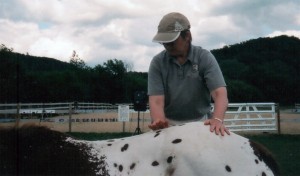Veterinary Spinal Manipulation or VSM, (also known as “animal chiropractic” in states other than Wisconsin)
- Restores normal motion to the spine, restoring flexibility, relieving pain and allowing movement with less effort. These are important for optimal performance by animal athletes as well as for quality of life for arthritic or geriatric animals.
- Helps insure the health and function of the various organs of the body by eliminating interference in the function of the nerves that supply those organs.
Please note that Veterinary Spinal Manipulation is not the same as Veterinary Orthopedic Manipulation (VOM).
Examination
A veterinarian who performs Veterinary Spinal Manipulation will assess an animal by watching it move and examining its skin and muscles for hot or cool spots, areas of swelling or atrophy and tightness or tenderness as well as checking each individual vertebra for position and for its ability to move through its complete normal range of motion.
Treatment
Veterinary Spinal Manipulation is accomplished by using the practitioner’s hands to apply a rapid but carefully modulated thrust to a specific part of a specific vertebrae in a specific direction. Bones are not “put into place” but are allowed to return to their normal position. In addition to mechanically freeing the vertebra this rapid thrust causes a burst of nerve activation that changes the nerve input to the brain. This effect may be even more important than the more obvious physical effects. When bone or soft tissue isn’t moving and functioning normally there is a decrease in the nerve input to the brain. By activating these nerves Veterinary Spinal Manipulation not only changes the input to the brain but changes the output from the brain having profound effects on the affected tissues. Vertebrae can also be freed and influenced with a slower form of manipulation but this may not result in the same sort of sensory stimulation that Veterinary Spinal Manipulation provides.
The timing and number of treatments required to resolve a problem depend on the condition being treated and the severity of the problem. A schedule of weekly treatments for two or three weeks is common. Chronic problems will require ongoing maintenance.
To make an appointment with Dr. Schilling please call 608-452-2185.
To find an American Veterinary Chiropractic Association certified doctor in your area visit www.animalchiropractic.org.


